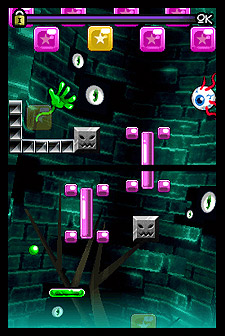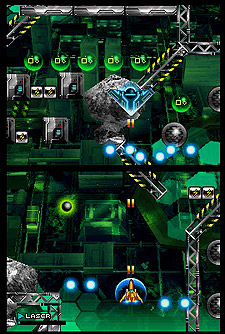Nervous Brickdown, the first effort from DS developer Arkedo Studio, was quite the pleasant surprise! I was skeptical that anyone could pull off a 'modern' interpretation of a Breakout/paddle-and-ball game that was engaging and original but, thanks to a litany of uniquely themed levels and an interesting mishmash of mechanics, they managed to do so in spades! However, one facet of the game's been picking at me since I started playing, and it's a crucial aspect of the DS that I've been waiting for a developer to confront for some time.
Even though the DS' design demands relegating your game between two screens, I really haven't seen many games actually use both screens to display the same field of view yet. Most games just shove a separate angle/map/cinematic/whatever in the less-active screen and call it a day, consequentially skirting the issue. But what happens when you're trying to display an entire area between the two screens? What of the space in-between the two screens, the piece of plastic that allows the DS to have its clamshell design? Is that area just unseen or is it simply meant to be forgotten? Is it negative space or simply ignored space?
That's the problem I faced while playing Nervous Brickdown. While I find the game extremely stylish, unique and engrossing, the game's dual-field perspective has me slightly puzzled. In most of the levels, you control the paddle at the bottom of the screen and watch the ball ricochet from the paddle up towards the top of the screen before either being deflected by an object or wall and falling back towards bottom again. Which means that, often, the ball passes through the space in-between them.
Nervous Breakdown chooses to confront this by simply ignoring the fact that the screens have any separator to begin with. In fact, on levels that allow you to place your paddle anywhere on the bottom screen, you can position it right at cusp of the top border and see the ball, comfortably resting, smack-dab on the bottom of the top screen.
And while, logically, this makes sense (the two screens are supposed to be married, inseparable), visually it's simply strange and incongruent. Sometimes the ball is moving so slow in Nervous Brickdown that you end up cross-eyed due to watching two halves of the ball scroll across both screens, wondering just what sort of abnormality can allow for this to occur. Then again, this way you don't have to wonder about what sort of madness may lay in store for the ball when it crosses over that may upset the ball's trajectory but, it simply feels like something should be inhabiting the plastic between the two screens.
Obviously, I haven't seen many titles address this head-on as a playability issue. Sonic Rush sprawls between the two screens, sort of, in that Sonic runs between both with intermittent frequency. However, most of the time he does so during periods where the player has little control over him, often when he's propelled by a platform/springboard/row of rings/etc. so, as far as playability is concerned, it's mostly a moot point (additionally, visually, he's often moving fast enough that it's practically seamless). I'm sure there's at least one 'shoot-em-up' that's out for the DS that also confronts this conundrum, but most that I've seen from the genre seem to inhabit just one screen (such as Nanostray).
So, those of you that are big DS players, do you have any thoughts on the matter? What do you expect to occur in-between the dual screens, if anything? Have you seen any other games take advantage of the space, or have any engaging ideas about how developers can use it? I wouldn't mind seeing more developers make use of the screens like separate camera angles, and 'cut' between the screen's like film editors do with standard continuity editing (which, arguably, Sonic Rush already does, but I'm talking using a multi-camera set-up). What do you think?
P.S. Just to clarify that I was only 'slightly puzzled' by this behavior – I doubt either approach to the game would have thrown me off of it either way. Nervous Brickdown is a nicely crafted, intriguing game (with a slightly unfortunate name) that I highly recommend, even if you aren't much of a Breakout/Arkanoid fan. Each level is slightly ingenious in one manner or another, and features exceptional visual and aural design. The 'Speed' level is particularly well-done and, with its wireframe graphics, electro soundtrack and tempo-based sensibilities, is probably as close to a Rez sequel as we're likely to get, the 'Paper' level has some damn charming music. And it has the best 'blow' mechanic I've ever seen in a DS-based game: You can keep your ball up in the air as long as you keep blowing on the microphone. Yes, this probably the only game that's made me physically dizzy. It's brilliant!
I do feel a bit sad about Arkado though, as their website comes across as more than a tad defeatist and self-depreciative (for instance, check out the 'Projects' and 'Jobs' pages), but this game's really quite a gem, and well-worth a look.






#1 viewtiful dru Jul 28, 2007 09:23am
Yoshi's Island DS abuses the space between the screens. I missed half of the damn red coins because Artoon thought it was cute to hide them there.
Still a great game IMO.
#2 Soup Jul 28, 2007 11:04am
I had similar experiences to dru with Yoshi's island DS. I found myself constantly shifting the camera up and down just to check out the "gutter."
Metroid Prime also keeps the gutter, but play isn't too affected, since they just don't put anything important there. If anything, since the inclusingof the gutter space maintains a proper perspective, it keeps ball angling natural.
the only experiences with no-gutter syndrome I've encountered is some art spreads in Phoenix Wright and Tetris DS (specifically the head2head challenge of FIRE mode). IN PW, it made the art look a little wonky (gameplay was not affected).
In the case ofTetris however,I've glad they kept out the gutter. Having to remember how the blocks are stacked in three non-visible rows is too challenging in a bad way.